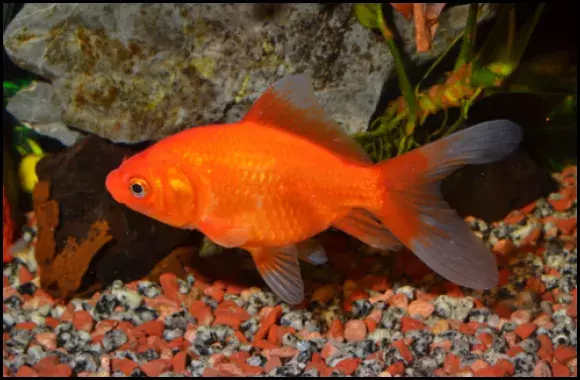
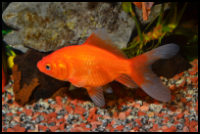
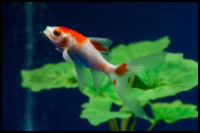
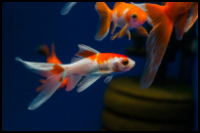
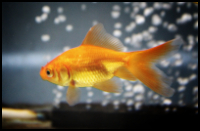
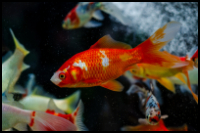
Quick Care Details (Table)
| Livestock Characteristics | Value |
|---|---|
| Care Level | Easy |
| Temperament | Peaceful |
| Diet | Omnivore |
| Maximum Size | 12 Inches |
| Minimum Tank Size | 75 Gallons |
| Plant Safe | Yes |
| Temperature Range | 65-75F |
| PH Range | 7.0-8.4 |
| KH Range | 4-8 dKH |
| GH Range | 5-15 dGH |
Species Specific Categories
Helpful Video
Care Details
Aquascape: When setting up a home for your Comet Goldfish, think about creating a lovely environment. You can add plants, rocks, and cool decorations to make their space feel cozy. Give them places to hide and plenty of room to swim around.
Substrate: The substrate is the stuff that covers the bottom of your pond or tank. For Comet Goldfish, it's a good idea to pick something easy to clean and not too sharp. Smooth gravel or a bare bottom works well, so their delicate barbels don't get hurt.
Disease Prevention: To keep your Comet Goldfish healthy, you've got to keep the water clean, feed them right, and make sure any new fish friends go through a quarantine period before joining the gang. Regularly check the water quality and maintain a consistent temperature.
Filtration: Think of a filter as your fish's cleaning crew. It helps take out waste and harmful stuff from the water. Look for a filter that does mechanical, biological, and chemical cleaning for the best results.
Lighting: Comet Goldfish usually do better when there's good light for the aquatic plants. If you've got plants in the tank or pond, make sure they get the right kind of light. Stick to a regular day and night schedule for your fishy pals.
Water Flow: Comet Goldfish like things just right – not too still, and not too wild. Make sure there's enough water movement to keep the oxygen levels up but not so much that it stresses them out. Good water circulation helps keep their home clean.
Hardiness: These fish are tough cookies. They can handle a wide range of water conditions, but it's still best to keep things stable and comfy for them. Whether indoors or outdoors, they're pretty adaptable.
Acclimation: When you bring in new fish, don't rush things. Let them get used to their new digs slowly. Adjust the water conditions and temperature over time to ease them into their new home.
Special Requirements: Comet Goldfish don't demand anything too fancy. Just remember to give them a balanced diet with good fish food, and maybe treat them to some live or frozen snacks like brine shrimp once in a while. Keep an eye on their growth, as they can get pretty big!
document.getElementById("care-details-next-tab").addEventListener("click", function() {
document.getElementById("temperament-tab").click();
});
Temperament and Behavior
Behavior and Social Interaction: Comet Goldfish are generally social and curious creatures. They like to explore their environment and interact with their tankmates. You'll often see them swimming around, checking out their surroundings, and even coming to the surface to say hello during feeding time.
Aggression: Comet Goldfish are not typically aggressive, but they can become territorial, especially during breeding or when competing for food. Providing plenty of space and hiding spots can help reduce any aggressive behavior. They usually get along well with other peaceful fish.
Breeding: Breeding Comet Goldfish can be a rewarding experience. To encourage breeding, you can provide a separate breeding tank with soft plants for egg attachment and controlled temperature and water conditions. When they're ready to spawn, the male will chase the female, and they'll release eggs and sperm into the water, where fertilization occurs.
Compatibility: Comet Goldfish are generally compatible with other goldfish varieties, such as other Comets, Shubunkins, or Fantails. They tend to do best with fish of similar size and temperament. Avoid pairing them with aggressive or fin-nipping species, as this can lead to stress and injury.
Activity Level: Comet Goldfish are active swimmers and are often seen darting around their habitat. They enjoy exploring and may display playful behavior, especially in a well-designed and spacious environment. You'll notice them being more active during feeding times and when they feel safe.
Schooling or Shoaling Behavior: Comet Goldfish are not shoaling fish, which means they don't swim in tight-knit groups like some other species. However, they are social and prefer the company of other goldfish. Keeping them with a few companions of their kind or compatible varieties can make them feel more secure and reduce stress.
document.getElementById("temperament-next-tab").addEventListener("click", function() {
document.getElementById("diet-tab").click();
});
document.getElementById("temperament-previous-tab").addEventListener("click", function() {
document.getElementById("care-details-tab").click();
});
Diet and Nutrition
Dry Foods: Comet Goldfish readily accept dry foods like pellets and flakes. High-quality commercial fish pellets or flakes formulated for goldfish provide essential nutrients and are convenient to feed. These foods are available in various sizes to suit the size of your goldfish.
Frozen Foods: Frozen foods are a nice treat for your Comet Goldfish. Options like frozen brine shrimp, bloodworms, and daphnia are rich in protein and can be offered occasionally to add variety to their diet. Thaw the frozen food before feeding to ensure it's safe for consumption.
Live Foods: Live foods, such as live brine shrimp or mosquito larvae, are highly appealing to Comet Goldfish and can be a source of essential nutrients. Feeding live foods on occasion can be a great way to provide a more natural and stimulating diet.
Vegetables: Comet Goldfish benefit from a diet that includes fresh or blanched vegetables. Offer vegetables like peas (without the skin), spinach, lettuce, and zucchini. These provide fiber and essential vitamins and minerals. Remove any uneaten portions to maintain water quality.
Algae: Comet Goldfish are omnivores and will graze on algae naturally present in their habitat. While they do eat some algae, it's essential not to rely solely on algae for their nutrition. A balanced diet with algae-based foods and other options is ideal.
Feeding Schedule: Establishing a regular feeding schedule is crucial for your goldfish's health. Feed them small portions 2-3 times a day, being mindful not to overfeed. Feed only what they can consume in a few minutes to prevent leftover food from fouling the water.
Supplemental Foods: Supplemental foods can be beneficial. You can include specially formulated goldfish foods that contain a variety of nutrients. Additionally, vitamin and mineral supplements can be added to their diet to ensure they receive all the essential nutrients.
document.getElementById("diet-previous-tab").addEventListener("click", function() {
document.getElementById("temperament-tab").click();
});
document.getElementById("diet-next-tab").addEventListener("click", function() {
document.getElementById("tank-parameters-tab").click();
});
Tank Parameters
Tank Size: Comet Goldfish can grow quite large, so it's essential to provide them with an adequately sized tank or pond. A general guideline is to have at least 20-30 gallons of water per Comet Goldfish in an aquarium. For outdoor ponds, they thrive in larger setups, with a minimum of 150 gallons per fish.
Tank Length and Measurements: When setting up an aquarium for Comet Goldfish, consider their body shape and size. A longer tank is better than a taller one because it provides more horizontal swimming space. A 55-gallon tank with dimensions around 48 inches in length, 12 inches in width, and 20 inches in height can be suitable for a pair of Comet Goldfish.
Water Temperature: Comet Goldfish are hardy and can tolerate a range of temperatures. Ideally, keep the water temperature between 65°F to 75°F (18°C to 24°C). They can handle colder temperatures as well, which makes them suitable for outdoor ponds in various climates.
pH (Acidity/Alkalinity): Comet Goldfish do well in water with a pH level in the range of 7.0 to 8.4. They can adapt to a slightly broader pH range, but maintaining stability in pH is more critical than aiming for a specific value.
KH (Carbonate Hardness): Carbonate hardness, or KH, helps buffer pH and stabilize the water. For Comet Goldfish, a KH level of 100-200 ppm (parts per million) is ideal to prevent rapid pH fluctuations.
GH (General Hardness): General hardness, or GH, relates to the mineral content in the water. Comet Goldfish thrive in water with GH levels around 150-300 ppm. This range ensures they receive essential minerals without excessive hardness.
Hardiness: Comet Goldfish are known for their hardiness, making them suitable for both beginners and experienced aquarists. They can adapt to a range of water conditions, but maintaining stable parameters is still important for their overall health and well-being.
Nitrate (NO3) Levels: Keep an eye on nitrate levels in your tank or pond to maintain good water quality. Nitrate should ideally be kept below 40 ppm. Regular water changes and a well-functioning filtration system will help control nitrate buildup.
document.getElementById("tank-parameters-previous-tab").addEventListener("click", function() {
document.getElementById("diet-tab").click();
});
History, Popularity, History and Species Variety Details
The History, Popularity, and Natural Habitat
History: Comet Goldfish have quite an interesting backstory. They were developed right here in the United States during the late 1800s. The name "comet" comes from their beautiful, comet-like tail fins, which were bred to be long and flowing. People put in a lot of effort to make them look as graceful as they do today.
Popularity: Comet Goldfish are like rockstars in the world of pet fish. They're super popular with folks who love keeping fish because they're not only pretty but also tough cookies. Whether you're new to fishkeeping or a seasoned pro, Comet Goldfish are a top pick. Their adaptability lets them thrive in all sorts of watery homes, from fancy indoor aquariums to serene outdoor ponds.
Habitat: In the wild, Comet Goldfish are originally from China. They're kind of like distant cousins of wild carp. You can find them hanging out in slow-moving or calm waters like ponds, lakes, and gentle rivers. These places are where they feel right at home. They munch on aquatic plants, algae, small critters, and other natural goodies.
Over time, people have selectively bred them to come in all sorts of colors, from fiery red to sunny orange and even funky calico patterns. They like having room to swim, some greenery, and hidey-holes. So, whether it's in their native waters or in your aquarium, Comet Goldfish are all about that chill, relaxed vibe.
In a nutshell, Comet Goldfish have a cool history of selective breeding in the U.S., they're super popular due to their good looks and hardy nature, and their natural habitat is in China, where they enjoy slow and calm waters, munching on all sorts of tasty treats.
Back to topVariations of The Comet Goldfish
- Sarasa Comet: Sarasa Comets have a striking red and white color pattern, creating a captivating and eye-catching appearance. They are popular for their contrasting colors.
- Red Comet: These Comets have a more intense and uniform red coloration compared to the standard Comet Goldfish, making them particularly vibrant and attractive.
- Yellow Comet: Yellow Comets display a predominantly yellow or gold coloration, adding a unique and sunny touch to outdoor ponds.
- Calico Comet: Calico Comets are known for their mottled or variegated coloring, which combines red, orange, black, and white patches. The calico pattern adds a sense of diversity and uniqueness to the Comet family.
- Black Comet: Black Comets, as the name suggests, have a predominantly black coloration. The contrast between their black color and bright red or orange eyes can be quite striking.
- Shubunkin Comet: Shubunkin Comets have a calico pattern similar to Shubunkin goldfish, featuring a mix of red, orange, blue, black, and white. They are a beautiful and popular variation.
Male gender vs Female gender (Sexual Dimorphism)
1. Size and Body Shape: When your Comet Goldfish starts growing and reaching maturity, you might notice that the females tend to be a bit larger and have a rounder body shape, especially during the breeding season. Males, on the other hand, tend to stay a tad smaller and appear slimmer.
2. Pectoral Fins: During the breeding season, males can develop tiny white spots on their pectoral fins. These spots are called breeding tubercles, and they feel a bit rough to the touch. These tubercles help males hold onto the females during the mating process. Females typically don't have these.
3. Behavior: Watch their behavior, especially when they're ready to spawn. Males might get a bit more active, chasing and courting the females in a bid to get their attention. You'll notice them being more aggressive as they try to court a mate.
4. Vent Area: If you look closely at the vent area, which is right in front of the anal fin, you might see some differences. In mature females, this area may appear slightly more rounded and swollen, especially when they're carrying eggs. Males usually have a more streamlined vent area.
Back to topPersonal Perspective
Yes, this is the fish you commonly find at Petco for just a few cents. This fish is likely the most abused in the aquarium hobby. These fish are usually sold as feeder fish due to the ease of breeding, but I believe this practice could be better. The reason is that these fish are typically packed into a tank with hundreds of other goldfish with no swimming space, poor water quality, and cheap food. This causes them to become very stressed and makes a situation ripe for breeding diseases and sharing parasites. A stressed fish is usually weakened and isn't very likely to fight off any sickness, meaning everything will spread like wildfire. So, we can conclude that these feeder fish will likely have an illness that you might be feeding to fish in your home aquarium. So now you will get your home aquarium infected with whatever that fish had and introduce other bacterial strains you probably don't want.
It is also very common for most new aquarium hobbyists to be under the impression that these fish will do fine in a small bowl or fish tank. I believe these fish are not meant for small tanks because they become huge and should live out in an outdoor pond or an extremely large aquarium. I would love to see more education on these fish and a reduction in their being sold in the big box stores. A phrase I really like that would apply to these fish is "cheaper isn't always better." Just because they are cheap doesn't mean getting one is a good idea.
If you understand all of my listed points and find that you still want this type of fish, I have found them extremely hardy and easy to care for. They are great additions to your pond, especially if you live in a cold geographical location. In the winter, you just need to make sure the whole pond's surface doesn't freeze over so the water can still exchange oxygen. Other than that, these guys will essentially hibernate and not require much, if any, food over the cold months. They are relatively peaceful and can generally do well with any other fish as long as they are big enough to avoid becoming food to an enormous catfish. So keep their size in mind and stock your pond accordingly.
Frequently Asked Questions
What's their lifespan?
Comet Goldfish can live for 10 to 15 years or more with proper care, so get ready for a long-lasting finned friend!
Are Comet Goldfish good for beginners in fishkeeping?
Yes, they are an excellent choice for beginners due to their hardiness. Just remember to provide the right space, proper care, and suitable water conditions.
How do I maintain water quality for my Comet Goldfish?
Regular water changes, good filtration, and monitoring water parameters like pH, ammonia, nitrite, and nitrate levels are crucial for maintaining water quality and keeping your Comet Goldfish healthy.
Can I keep Comet Goldfish with other fish in the same tank or pond?
Yes, they can be kept with other peaceful fish of similar size and temperament. Just ensure that the tank or pond is spacious enough to accommodate all the fish comfortably.
What's the best diet for Comet Goldfish?
Comet Goldfish thrive on a balanced diet of high-quality fish pellets, flakes, and occasional treats like live or frozen foods. Fresh vegetables like peas and blanched spinach are also great. Don't overfeed, as it can affect water quality.
How can I tell the gender of my Comet Goldfish?
Observing their size, body shape, and behavior during the breeding season can give you clues. Males are typically a bit smaller and may develop white breeding tubercles on their pectoral fins during mating.
Do Comet Goldfish need a heater for their water?
Not usually. They are hardy fish and can tolerate a wide range of temperatures. However, a heater may be necessary if you live in a very cold climate or plan to keep them in a pond during the winter.
Can I keep Comet Goldfish in a regular fish tank?
Yes, you can keep Comet Goldfish in an aquarium, but be prepared for their growth. They need plenty of space as they get bigger, so consider a larger tank or even better, an outdoor pond.
How big do Comet Goldfish get?
Comet Goldfish can grow quite large. On average, they reach 10 to 12 inches in length, but in ideal conditions, they can grow even larger.
What's a Comet Goldfish, and why are they called "Comet"?
A Comet Goldfish is a type of goldfish with a unique long, flowing tail fin that resembles a comet's tail as they swim gracefully. They're named "Comet" due to this striking feature.

